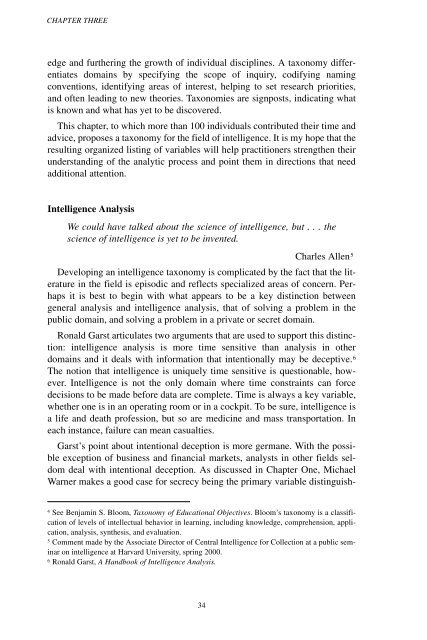Analytic Culture in the U.S. Intelligence Community (PDF) - CIA
Analytic Culture in the U.S. Intelligence Community (PDF) - CIA
Analytic Culture in the U.S. Intelligence Community (PDF) - CIA
Create successful ePaper yourself
Turn your PDF publications into a flip-book with our unique Google optimized e-Paper software.
CHAPTER THREE<br />
edge and fur<strong>the</strong>r<strong>in</strong>g <strong>the</strong> growth of <strong>in</strong>dividual discipl<strong>in</strong>es. A taxonomy differentiates<br />
doma<strong>in</strong>s by specify<strong>in</strong>g <strong>the</strong> scope of <strong>in</strong>quiry, codify<strong>in</strong>g nam<strong>in</strong>g<br />
conventions, identify<strong>in</strong>g areas of <strong>in</strong>terest, help<strong>in</strong>g to set research priorities,<br />
and often lead<strong>in</strong>g to new <strong>the</strong>ories. Taxonomies are signposts, <strong>in</strong>dicat<strong>in</strong>g what<br />
is known and what has yet to be discovered.<br />
This chapter, to which more than 100 <strong>in</strong>dividuals contributed <strong>the</strong>ir time and<br />
advice, proposes a taxonomy for <strong>the</strong> field of <strong>in</strong>telligence. It is my hope that <strong>the</strong><br />
result<strong>in</strong>g organized list<strong>in</strong>g of variables will help practitioners streng<strong>the</strong>n <strong>the</strong>ir<br />
understand<strong>in</strong>g of <strong>the</strong> analytic process and po<strong>in</strong>t <strong>the</strong>m <strong>in</strong> directions that need<br />
additional attention.<br />
<strong>Intelligence</strong> Analysis<br />
We could have talked about <strong>the</strong> science of <strong>in</strong>telligence, but . . . <strong>the</strong><br />
science of <strong>in</strong>telligence is yet to be <strong>in</strong>vented.<br />
Charles Allen 5<br />
Develop<strong>in</strong>g an <strong>in</strong>telligence taxonomy is complicated by <strong>the</strong> fact that <strong>the</strong> literature<br />
<strong>in</strong> <strong>the</strong> field is episodic and reflects specialized areas of concern. Perhaps<br />
it is best to beg<strong>in</strong> with what appears to be a key dist<strong>in</strong>ction between<br />
general analysis and <strong>in</strong>telligence analysis, that of solv<strong>in</strong>g a problem <strong>in</strong> <strong>the</strong><br />
public doma<strong>in</strong>, and solv<strong>in</strong>g a problem <strong>in</strong> a private or secret doma<strong>in</strong>.<br />
Ronald Garst articulates two arguments that are used to support this dist<strong>in</strong>ction:<br />
<strong>in</strong>telligence analysis is more time sensitive than analysis <strong>in</strong> o<strong>the</strong>r<br />
doma<strong>in</strong>s and it deals with <strong>in</strong>formation that <strong>in</strong>tentionally may be deceptive. 6<br />
The notion that <strong>in</strong>telligence is uniquely time sensitive is questionable, however.<br />
<strong>Intelligence</strong> is not <strong>the</strong> only doma<strong>in</strong> where time constra<strong>in</strong>ts can force<br />
decisions to be made before data are complete. Time is always a key variable,<br />
whe<strong>the</strong>r one is <strong>in</strong> an operat<strong>in</strong>g room or <strong>in</strong> a cockpit. To be sure, <strong>in</strong>telligence is<br />
a life and death profession, but so are medic<strong>in</strong>e and mass transportation. In<br />
each <strong>in</strong>stance, failure can mean casualties.<br />
Garst’s po<strong>in</strong>t about <strong>in</strong>tentional deception is more germane. With <strong>the</strong> possible<br />
exception of bus<strong>in</strong>ess and f<strong>in</strong>ancial markets, analysts <strong>in</strong> o<strong>the</strong>r fields seldom<br />
deal with <strong>in</strong>tentional deception. As discussed <strong>in</strong> Chapter One, Michael<br />
Warner makes a good case for secrecy be<strong>in</strong>g <strong>the</strong> primary variable dist<strong>in</strong>guish-<br />
4<br />
See Benjam<strong>in</strong> S. Bloom, Taxonomy of Educational Objectives. Bloom’s taxonomy is a classification<br />
of levels of <strong>in</strong>tellectual behavior <strong>in</strong> learn<strong>in</strong>g, <strong>in</strong>clud<strong>in</strong>g knowledge, comprehension, application,<br />
analysis, syn<strong>the</strong>sis, and evaluation.<br />
5<br />
Comment made by <strong>the</strong> Associate Director of Central <strong>Intelligence</strong> for Collection at a public sem<strong>in</strong>ar<br />
on <strong>in</strong>telligence at Harvard University, spr<strong>in</strong>g 2000.<br />
6<br />
Ronald Garst, A Handbook of <strong>Intelligence</strong> Analysis.<br />
34
















